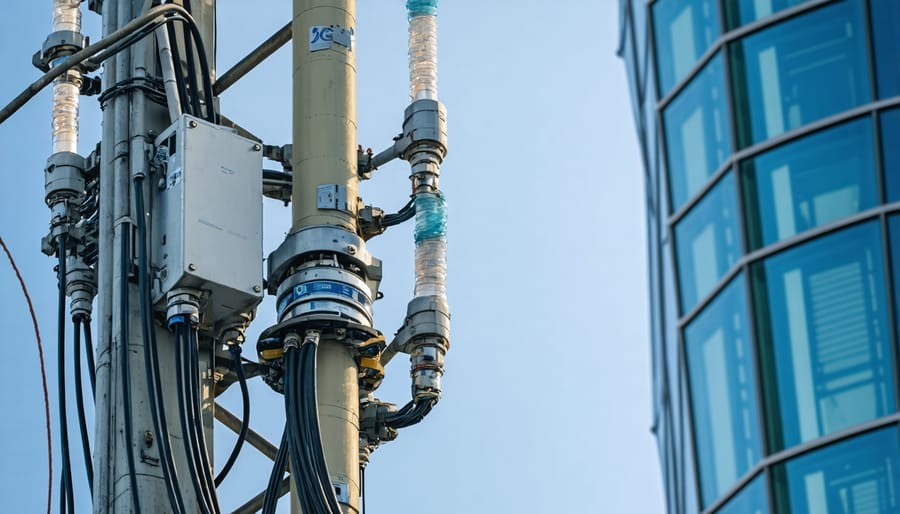Digital infrastructure forms the invisible backbone of modern cities, powering everything from traffic management systems to public utilities and emergency response networks that are transforming urban planning. This critical framework encompasses interconnected systems of data centers, fiber-optic networks, IoT sensors, and cloud computing platforms that enable seamless communication, data processing, and service delivery across urban environments.
From intelligent transportation systems that optimize traffic flow to smart grid technologies that modernize power distribution, digital infrastructure examples demonstrate how technology integration is revolutionizing urban operations. These systems create a foundation for data-driven decision-making, enhanced public services, and improved quality of life for citizens.
Construction professionals and urban planners must understand these digital components as essential elements of modern infrastructure projects, equal in importance to traditional physical assets like roads and utilities. The integration of digital systems with conventional infrastructure creates robust, responsive urban environments capable of meeting the complex demands of 21st-century cities.
This comprehensive examination explores real-world implementations, technical specifications, and strategic considerations for developing effective digital infrastructure solutions in contemporary urban development projects.

Core Components of Urban Digital Infrastructure
Smart Grid Networks
Modern cities increasingly rely on smart grid networks as foundational elements of their digital infrastructure. These intelligent power distribution systems integrate advanced metering infrastructure (AMI), distribution automation, and real-time monitoring capabilities to optimize energy delivery and consumption patterns.
At their core, smart grids utilize sophisticated sensor networks and IoT devices to collect granular data about power usage, grid performance, and potential disruptions. This data enables utilities to implement dynamic load balancing, predictive maintenance, and automated fault detection, significantly improving grid reliability and efficiency.
Key components include smart meters, which provide two-way communication between consumers and utilities, distribution management systems that optimize power flow, and advanced energy storage solutions that help manage peak demand. The integration of renewable energy sources is facilitated through intelligent controls that automatically adjust to varying generation levels from solar and wind installations.
These systems demonstrate particular value during extreme weather events or peak usage periods, where they can implement automated demand response programs and selective load shedding to maintain grid stability and prevent widespread outages.
Urban Data Centers
Urban data centers serve as the backbone of modern smart city operations, housing critical digital infrastructure that processes and stores vast amounts of municipal data. These facilities integrate multiple systems, including traffic management, emergency services, utilities monitoring, and public service delivery platforms.
Typical urban data centers feature redundant power systems, advanced cooling infrastructure, and high-speed fiber-optic connectivity. They employ tier-classification standards (typically Tier III or IV) to ensure 99.999% uptime reliability for essential city services. Modern facilities increasingly incorporate edge computing capabilities to reduce latency in real-time applications such as automated traffic control and emergency response systems.
Security measures in these facilities include multiple authentication layers, biometric access controls, and 24/7 surveillance systems. Environmental considerations have led to the implementation of energy-efficient designs, with many centers utilizing renewable energy sources and free cooling techniques where climate permits.
Case studies show that successful urban data centers often operate through public-private partnerships, allowing cities to leverage expertise from technology providers while maintaining control over critical infrastructure and data sovereignty. This hybrid approach has proven effective in balancing operational efficiency with public service requirements.
Connectivity and Communication Networks
5G and Fiber Optic Networks
The deployment of 5G networks and fiber optic infrastructure represents a critical advancement in digital connectivity, forming the backbone of smart city initiatives and modern digital operations. 5G technology delivers ultra-fast wireless connections with minimal latency, enabling real-time data processing for autonomous vehicles, smart sensors, and IoT devices across urban environments.
Fiber optic networks complement 5G deployment by providing the essential backhaul infrastructure needed to support high-bandwidth data transmission. These networks utilize advanced optical fiber cables capable of transmitting data at speeds up to 100 gigabits per second, establishing reliable connections between cell towers, data centers, and end-users.
Recent infrastructure projects have demonstrated the synergy between 5G and fiber networks. For instance, the Smart City initiative in Barcelona has implemented over 500 kilometers of fiber optic cable alongside strategic 5G node placement, enabling comprehensive digital service delivery throughout the metropolitan area.
Key implementation considerations include:
– Strategic placement of 5G small cells to ensure optimal coverage
– Integration with existing fiber optic backbone networks
– Redundancy planning for network reliability
– Future-proofing through scalable infrastructure design
– Compliance with electromagnetic radiation guidelines
Construction professionals must coordinate closely with telecommunications experts during installation, particularly when integrating these systems into existing urban infrastructure. This often requires specialized equipment and expertise in both underground cable installation and wireless network configuration.

IoT Sensor Networks
IoT sensor networks represent a cornerstone of modern digital infrastructure, enabling cities to collect and analyze real-time data across multiple urban systems. These networks typically consist of interconnected sensors strategically deployed throughout urban environments to monitor various parameters such as air quality, traffic flow, energy consumption, and structural health of buildings and bridges.
A comprehensive IoT sensor network usually incorporates multiple layers of technology, including environmental sensors, smart meters, and structural monitoring devices. These sensors communicate through secure wireless protocols, transmitting data to central management systems for analysis and decision-making. For instance, advanced cities like Singapore have implemented over 50,000 sensors to monitor everything from crowd density to flood levels.
The implementation of sensor networks requires careful consideration of power requirements, communication protocols, and data security. Many modern deployments utilize low-power wide-area networks (LPWAN) technology, enabling sensors to operate for years on single battery charges while maintaining reliable connectivity. Data collected through these networks supports various urban services, from predictive maintenance of infrastructure to emergency response systems.
Construction professionals should particularly note the integration capabilities of IoT sensors with building management systems (BMS) and structural health monitoring platforms. These integrations enable real-time monitoring of building performance, energy efficiency, and structural integrity, providing valuable insights for maintenance and optimization of built assets.
Digital Infrastructure Management Systems
Smart Traffic Management
Smart traffic management systems represent a cornerstone of modern digital infrastructure, integrating advanced sensors, artificial intelligence, and real-time data analytics to optimize urban mobility. These systems utilize a network of interconnected devices, including smart traffic signals, surveillance cameras, and vehicle detection sensors, to monitor and regulate traffic flow dynamically.
At the heart of these systems are adaptive traffic signal controls that automatically adjust timing patterns based on current traffic conditions. For instance, cities like Singapore and London employ AI-powered traffic management centers that process data from thousands of sensors to reduce congestion by up to 20% during peak hours.
Vehicle detection systems using magnetic loops, radar, and computer vision technology provide real-time traffic density information. This data enables intelligent routing systems that can redirect traffic during incidents or peak congestion periods. Emergency vehicle preemption systems automatically adjust traffic signals to create clear paths for emergency responders, significantly reducing response times.
Modern smart traffic solutions also incorporate connected vehicle technology (V2X), allowing direct communication between vehicles and infrastructure. This enables features like queue warning systems and speed harmonization, which have been shown to reduce accidents by up to 30% in pilot programs.
Digital traffic management platforms typically include:
– Real-time traffic monitoring and analysis
– Automated incident detection
– Dynamic message signs
– Integrated parking management
– Public transportation priority systems
– Pedestrian safety systems

Urban Service Platforms
Modern cities are increasingly leveraging sophisticated digital platforms to streamline urban service management and enhance operational efficiency. These platforms integrate various municipal services, from utilities and transportation to emergency response systems, creating a cohesive digital ecosystem that serves both administrators and citizens.
Key components typically include real-time monitoring systems for water and power distribution, intelligent traffic management solutions, and automated waste management systems. For instance, smart meters and sensors continuously collect data on utility consumption patterns, enabling precise resource allocation and predictive maintenance scheduling. This data-driven approach significantly reduces operational costs while improving service reliability.
Municipal governments are implementing centralized command centers that aggregate information from multiple sources, providing comprehensive oversight of city operations. These centers utilize advanced analytics to optimize service delivery and respond swiftly to disruptions or emergencies. Smart grid technologies enable dynamic load balancing and efficient energy distribution, while integrated transportation platforms coordinate public transit systems and traffic flow management.
Digital payment systems and citizen engagement portals have become essential elements of urban service platforms, facilitating seamless interactions between residents and city services. These solutions not only enhance service accessibility but also provide valuable data insights for future infrastructure planning and development, creating more responsive and sustainable urban environments.
Implementation Challenges and Solutions
The implementation of digital infrastructure presents several significant challenges that construction professionals and urban planners must navigate carefully. One primary obstacle is the integration of legacy systems with new digital solutions, particularly in established urban environments where existing infrastructure may be decades old. This challenge often requires careful planning and phased implementation approaches to minimize disruption to essential services.
Cost management remains a critical concern, with initial capital expenditure and ongoing maintenance expenses presenting urban resilience challenges that demand innovative financing solutions. Organizations are increasingly turning to public-private partnerships and performance-based contracts to distribute financial risks and ensure sustainable implementation.
Cybersecurity vulnerabilities pose another significant challenge, as interconnected digital systems become potential targets for cyber attacks. Solutions include implementing robust security protocols, regular security audits, and maintaining encrypted communication channels between different infrastructure components. Additionally, creating redundant systems and backup solutions helps ensure continuity of service during potential security breaches.
Technical expertise gaps within existing workforce teams often hamper implementation efforts. Successful organizations address this through comprehensive training programs, partnerships with technology providers, and strategic hiring of digital specialists. Some municipalities have established dedicated digital transformation teams to oversee implementation and provide necessary technical guidance.
Interoperability between different systems and platforms presents ongoing challenges, particularly when integrating solutions from multiple vendors. The adoption of open standards and APIs has emerged as a crucial solution, enabling seamless communication between various digital infrastructure components. Organizations are increasingly specifying interoperability requirements in their procurement processes to ensure long-term system compatibility.
Data management and privacy concerns require careful consideration, especially with growing regulatory requirements. Successful implementations typically include robust data governance frameworks, clear privacy policies, and transparent data handling procedures. Regular stakeholder engagement and communication help maintain trust and support throughout the implementation process.
Digital infrastructure has become the backbone of modern urban development, fundamentally transforming how cities operate and deliver services to their residents. As we’ve explored throughout this article, from cloud computing systems to smart city sensors, these digital foundations are essential for creating efficient, sustainable, and resilient urban environments. The future outlook for digital infrastructure development is remarkably promising, with emerging technologies like 5G networks, artificial intelligence, and the Internet of Things driving innovation across all sectors.
Industry leaders must recognize that investing in robust digital infrastructure is no longer optional but crucial for maintaining competitiveness and meeting evolving societal needs. The integration of digital systems will continue to accelerate, requiring construction professionals to adapt their approaches and skill sets accordingly. Success in this evolving landscape demands careful consideration of scalability, security, and interoperability when planning and implementing digital infrastructure projects.
As we look ahead, the focus must remain on creating flexible, adaptive systems that can accommodate future technological advances while ensuring reliability and accessibility for all stakeholders. The construction industry’s role in shaping this digital future cannot be understated, as it bridges the physical and digital realms in our increasingly connected world.

